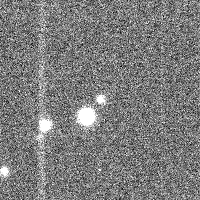(471143) 2010 EK139
|
Discovery images taken with the 1.3-meter Warsaw Telescope at Las Campañas, Chile | |
| Discovery [1][2] | |
|---|---|
| Discovered by |
A. Udalski S. S. Sheppard M. Kubiak C. Trujillo |
| Discovery site | Las Campañas Obs. |
| Discovery date | 13 March 2010 |
| Designations | |
| MPC designation | (471143) 2010 EK139 |
| TNO[3] · SDO · 2:7[4] | |
| Orbital characteristics [3] | |
| Epoch 31 July 2016 (JD 2457600.5) | |
| Uncertainty parameter 3 | |
| Observation arc | 13.16 yr (4,808 days) |
| Aphelion | 107.76 AU |
| Perihelion | 32.574 AU |
| 70.165 AU | |
| Eccentricity | 0.5358 |
| 587.75 yr (214,675 days) | |
| 346.47° | |
| 0° 0m 6.12s / day | |
| Inclination | 29.426° |
| 346.09° | |
| 284.25° | |
| Known satellites | None[5] |
| Physical characteristics | |
| Dimensions |
470+35 −10 km[5] 697 km[6] |
| 7.07±0.05[7] | |
|
0.10 (assumed)[6] 0.25+0.02 −0.05[5] | |
|
19.6 (R)[4] 19.9[8] | |
|
3.8[3] 3.8±0.1[5] 3.89±0.04 (S)[7] | |
|
| |
(471143) 2010 EK139 is a trans-Neptunian object orbiting the Sun in the scattered disc. It was discovered on 13 March 2010, at the Chilean Las Campañas Observatory by astronomers Andrzej Udalski, Scott S. Sheppard, Marcin Kubiak and Chad Trujillo.[1] The discovery was made during the Polish OGLE project of Warsaw University.[9] Based on its absolute magnitude and assumed albedo, it is very likely a dwarf planet[10] with a calculated diameter of approximately 470 kilometers.[5]
Distance
The minor planet orbits the Sun at a distance of 32.6–107.8 AU once every 587 years and 9 months (214,675 days) and reach perihelion in 2038. Its orbit has a high eccentricity of 0.54 and an inclination of 29° with respect to the ecliptic.[3] It It is currently 39.1 AU from the Sun.[8]A ten-million-year integration of the orbit shows that this object is in a 2:7 resonance with Neptune.[4]
The first precovery was taken by the Near-Earth Asteroid Tracking at Palomar Observatory in 2002, extending the minor planet's observation arc by 8 years prior to its discovery observation. Since then it has been observed 143 times over 6 oppositions and has an orbit quality of 1.[1]
Physical properties
In 2010, the thermal radiation of 2010 EK139 was observed by the Herschel Space Telescope, which allowed astronomers to estimate its diameter at about 470 kilometres (290 mi).[5]
Published in May 2013, a rotational light-curve for this minor planet was obtained from photometric observations at the discovering observatory with the 2.5-meter Irénée du Pont Telescope. It gave a rotation period of 7.07±0.05 hours with a brightness variation of 0.12 magnitude (U=2).[7]
Observations by American astronomer Michael Brown, using the Keck telescope in March 2012, suggest that there is no satellite, which makes determination of its mass impossible.[5]
See also
References
- 1 2 3 "471143 (2010 EK139)". Minor Planet Center. Retrieved 21 September 2016.
- ↑ "MPEC 2010-G49 : 2010 EK139". IAU Minor Planet Center. 2010-04-08. Retrieved 2010-12-03.
- 1 2 3 4 "JPL Small-Body Database Browser: 471143 (2010 EK139)" (2015-05-14 last obs.). Jet Propulsion Laboratory. Retrieved 21 September 2016.
- 1 2 3 Marc W. Buie. "Orbit Fit and Astrometric record for 10EK139" (2010-04-09 using 32 of 32 observations). SwRI (Space Science Department). Retrieved 2010-12-02.
- 1 2 3 4 5 6 7 Pál, A.; Kiss, C.; Müller, T. G.; Santos-Sanz, P.; Vilenius, E.; Szalai, N.; et al. (May 2012). ""TNOs are Cool": A survey of the trans-Neptunian region. VII. Size and surface characteristics of (90377) Sedna and 2010 EK139" (PDF). Astronomy and Astrophysics. 541: 4. arXiv:1204.0899
 . Bibcode:2012A&A...541L...6P. doi:10.1051/0004-6361/201218874. Retrieved 21 September 2016.
. Bibcode:2012A&A...541L...6P. doi:10.1051/0004-6361/201218874. Retrieved 21 September 2016. - 1 2 "LCDB Data for (471143)". Asteroid Lightcurve Database (LCDB). Retrieved 21 September 2016.
- 1 2 3 Benecchi, Susan D.; Sheppard, Scott S. (May 2013). "Light Curves of 32 Large Transneptunian Objects". The Astronomical Journal. 145 (5): 19. arXiv:1301.5791
 . Bibcode:2013AJ....145..124B. doi:10.1088/0004-6256/145/5/124. Retrieved 21 September 2016.
. Bibcode:2013AJ....145..124B. doi:10.1088/0004-6256/145/5/124. Retrieved 21 September 2016. - 1 2 "AstDys 2010EK139 Ephemerides". Department of Mathematics, University of Pisa, Italy. Retrieved 2010-12-11.
- ↑ Krzysztof Urbański (4 May 2010). "Układ Słoneczny coraz większy". Rzeczpospolita. Retrieved 4 May 2010. (English translation)
- ↑ Michael E. Brown. "How many dwarf planets are there in the outer solar system? (updates daily)". California Institute of Technology. Retrieved 20 September 2016.
External links
- MPEC 2010 G50 : 2010 EK139, Minor Planet Electronic Circular, issued on 8 April 2010
- OCKS: OGLE Carnegie Kuiper belt Survey (OCKS is a Southern sky survey searching for Kuiper-belt objects and dwarf planets)
- List Of Centaurs and Scattered-Disk Objects, Minor Planet Center
- Orbital simulation from JPL (Java) / Horizons Ephemeris
- (471143) 2010 EK139 at the JPL Small-Body Database


_(cropped).jpg)
